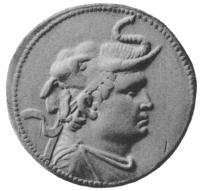Gandhara
Gandhara was an ancient region located in the northern part of Pakistan and eastern Afghanistan. Known for its rich cultural heritage and strategic geographical position, Gandhara played a significant role in the history of the Indian subcontinent and Central Asia. It was a melting pot of various cultures, including Greek, Persian, and Indian, which influenced its art, architecture, language, and religion.
History[edit | edit source]
The history of Gandhara spans several millennia, with its earliest settlements dating back to the Neolithic period. However, Gandhara is most renowned for its period of flourishing under the influence of the Achaemenid Empire of Persia in the 6th century BCE and subsequently under the rule of Alexander the Great in the 4th century BCE. Following Alexander's departure, Gandhara became a part of the Mauryan Empire, where it was significantly influenced by Buddhism under the reign of Emperor Ashoka.
After the fall of the Mauryan Empire, Gandhara was ruled by a succession of foreign invaders, including the Greeks, Scythians, Parthians, and Kushans, each leaving a distinct mark on the region's culture and traditions. The Kushan period, in particular, is noted for the development of the Gandhara School of Art, which combined Greek, Persian, and Indian elements.
Gandhara School of Art[edit | edit source]
The Gandhara School of Art is perhaps what Gandhara is best known for. Flourishing between the 1st and 5th centuries CE, this school of art is characterized by its distinctive style of Buddhist visual art that incorporated Hellenistic or Greco-Roman artistic techniques. The art forms included statues of the Buddha and Bodhisattvas, which were made using grey schist or stucco, and depicted them in a realistic and human form, a departure from the symbolic representations common in other regions.
Religion[edit | edit source]
Initially, the region practiced a form of ancient Vedic religion but gradually Buddhism took root in Gandhara, especially from the 3rd century BCE onwards, following Emperor Ashoka's conversion and promotion of Buddhism. Gandhara became a thriving center for Buddhism and played a crucial role in the spread of Buddhism to Central Asia and China. Alongside Buddhism, other religions such as Hinduism and Zoroastrianism were also practiced in Gandhara.
Language and Script[edit | edit source]
The primary languages of Gandhara were Gandhari, a Prakrit language, and Sanskrit. The Gandhari language was written using the Kharosthi script, which was derived from Aramaic script. Sanskrit texts were also prevalent, especially in the later periods, reflecting the region's participation in the broader cultural and religious developments of the Indian subcontinent.
Decline[edit | edit source]
Gandhara's decline began in the 5th century CE, following invasions by the Huns and later the Muslim conquests in the 7th century CE. These invasions led to a gradual decline in the region's Buddhist culture and the eventual absorption of Gandhara into the emerging Islamic empires.
Legacy[edit | edit source]
The legacy of Gandhara is preserved in its art and archaeological sites, which continue to be a subject of study for historians and archaeologists. The region's unique blend of cultures and traditions, especially its contributions to Buddhist art and philosophy, have left a lasting impact on the cultural heritage of South Asia and Buddhism worldwide.
Search WikiMD
Ad.Tired of being Overweight? Try W8MD's physician weight loss program.
Semaglutide (Ozempic / Wegovy and Tirzepatide (Mounjaro / Zepbound) available.
Advertise on WikiMD
|
WikiMD's Wellness Encyclopedia |
| Let Food Be Thy Medicine Medicine Thy Food - Hippocrates |
Translate this page: - East Asian
中文,
日本,
한국어,
South Asian
हिन्दी,
தமிழ்,
తెలుగు,
Urdu,
ಕನ್ನಡ,
Southeast Asian
Indonesian,
Vietnamese,
Thai,
မြန်မာဘာသာ,
বাংলা
European
español,
Deutsch,
français,
Greek,
português do Brasil,
polski,
română,
русский,
Nederlands,
norsk,
svenska,
suomi,
Italian
Middle Eastern & African
عربى,
Turkish,
Persian,
Hebrew,
Afrikaans,
isiZulu,
Kiswahili,
Other
Bulgarian,
Hungarian,
Czech,
Swedish,
മലയാളം,
मराठी,
ਪੰਜਾਬੀ,
ગુજરાતી,
Portuguese,
Ukrainian
Medical Disclaimer: WikiMD is not a substitute for professional medical advice. The information on WikiMD is provided as an information resource only, may be incorrect, outdated or misleading, and is not to be used or relied on for any diagnostic or treatment purposes. Please consult your health care provider before making any healthcare decisions or for guidance about a specific medical condition. WikiMD expressly disclaims responsibility, and shall have no liability, for any damages, loss, injury, or liability whatsoever suffered as a result of your reliance on the information contained in this site. By visiting this site you agree to the foregoing terms and conditions, which may from time to time be changed or supplemented by WikiMD. If you do not agree to the foregoing terms and conditions, you should not enter or use this site. See full disclaimer.
Credits:Most images are courtesy of Wikimedia commons, and templates, categories Wikipedia, licensed under CC BY SA or similar.
Contributors: Prab R. Tumpati, MD






